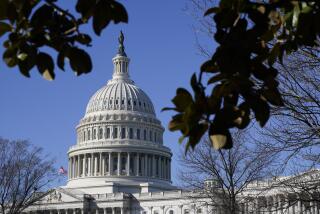District maps draw a new political landscape
Reporting from Sacramento and Washington -- California’s new voting districts could put Democrats within reach of as many as five more seats in Congress and enough in the state Legislature for the two-thirds majority needed to raise taxes, according to Democratic and Republican analysts.
Draft maps of the new political boundaries, drawn for the first time by an independent panel rather than party bosses, were released Friday and are expected to usher in the most dramatic shakeup of California’s state and federal offices in decades. Eventually, some powerful incumbents could lose their jobs.
“You’re looking at three to five Republican members of Congress that just kind of vanish,” said Matt Rexroad, a Republican political consultant in Sacramento who advises clients on redistricting. The prospect of Democrats securing two-thirds of both state legislative houses is “very much in play,” he said. No single party has held a supermajority in both the Assembly and Senate in many decades.
Interactive: Has your district been redrawn?
The maps are a work in progress, subject to change until the California Citizens Redistricting Commission’s Aug. 15 deadline to complete its task. It is charged with keeping together neighborhoods, ethnic groups, socioeconomic groups and other “communities of interest” without regard to their party registration or any risk to current officeholders.
Latino groups sharply criticized the proposed new districts, arguing that they would give one of California’s fastest-growing ethnic populations even less political power than it has now. Arturo Vargas, executive director of the National Assn. of Latino Elected and Appointed Officials and a veteran of reapportionment battles, called the new maps the “worst-case scenario for Latinos in California.”
“These maps in no way reflect the population shifts of the past 10 years,” he said. “Latinos accounted for 90% of the state’s population increase….[Yet] we actually end up with less than what we have now.”
Officials from the Mexican American Legal Defense and Educational Fund said the commission appeared to make keeping cities and other communities together a higher priority than the federal Voting Rights Act, which protects minorities’ representation opportunities.
He said the maps appear to provide no net gain in Latino-majority districts, although Latinos accounted for 90% of the state’s population growth over the past decade.
While the commission seemed to create new Latino-majority districts in some areas — such as in the east San Fernando Valley area currently represented by Rep. Howard L. Berman (D-Valley Village) — it did away with others.
Neither are many officeholders — Republicans and Democrats alike — satisfied with the first round of maps.
U.S. Rep. Mike Thompson (D-St. Helena) is part of the chorus calling for major revisions.
“It’s not about me or any of my colleagues,” he said. “They disenfranchise the North Coast. They made one continuous congressional district from the Golden Gate Bridge to the Oregon border, whereas in the past we had two voices for the people in that area, and now we have one.
“I’m hearing from people from one end of the coast to the other who are very upset,” he said.
Gabino Aguirre, a member of the commission, defended its work, saying the new process ends a system in which incumbents were able to choose their own voters, and reelection was often a foregone conclusion.
“I project that we are going to see a spike in citizen participation and more interest in the politics of California and nationally as well,” he said.
Between now and mid-August, the commission, created by voters in 2008, will take public input, make refinements and adjust the boundaries. The lines the panel finally settle on will be used in every election for at least 10 years, beginning in 2012 unless they are changed in the wake of the lawsuits that are sure to come. Various interests have been threatening them since the commission began its work.
“Part of what we’re going to be doing is going out again and asking the public, ‘How did we do? Do these maps reasonably, closely represent what you wanted us to do?’” said Stanley Forbes, a member of the commission. “We’ll be looking for the public to tell us.”
It is almost certain that some of the state’s prominent politicians — whose districts had long been drawn by friendly partisans — will soon be seeking reelection from voters with whom they have little in common, battling for turf with fellow officeholders they consider friends or facing such grim electoral prospects that they will opt to retire.
Reps. David Dreier and Gary Miller appear endangered by the proposed new maps.
Ideological allies such as Howard Berman and Brad Sherman found their districts partly melded.
Many safe seats in the Legislature could suddenly become competitive enough to put more centrists in the Capitol and ease its notorious gridlock.
Voters may even hand the already dominant Democrats undiluted legislative power.
Throughout California, many of the potential new districts are “virtually unrecognizable” compared to their current configurations, said UC Berkeley political scientist Bruce Cain, a reapportionment expert. “You can scratch your head trying to figure out who goes where.”
Some officeholders were already scrambling for a new place to hang their hats. Some were plotting a possible challenge to Republican Congressman Dreier of San Dimas, whose district has, at least for now, been carved into pieces that lean more heavily Latino and Democratic.
State Assemblyman Anthony Portantino (D-La Cañada Flintridge) had already been raising money for a run in that territory. And state Sen. Gloria Negrete McLeod (D-Chino) told a reporter in legislative chambers Friday that she saw opportunity in a proposed new district currently made up partly of Dreier’s constituents.
“I saw the map. That’s mine,” she said.
Potential challengers are also circling Berman. The part of his territory that may not overlap Sherman’s would be merged with a heavily Latino district. Los Angeles City Councilman Tony Cardenas announced hours after the maps were posted that he would seek to represent that area in Congress.
Rep. Bob Filner, a Democrat, is opting to run for San Diego mayor rather than try to run again for Congress in a more heavily Latino district. State Sen. Juan Vargas (D-San Diego) announced that he would run for the congressional seat.
In Washington, some GOP strategists expressed confidence that Republicans would be able to compete in some of the proposed new districts that appear to favor Democrats, possibly limiting the loss of seats to just one or two. But analysts were predicting otherwise.
“At minimum, [Democrats] should pick up two to three seats, but that could go as high as four to five,” said David Wasserman, House editor of the Washington-based Cook Political Report, which monitors redistricting.
Some politicians warned the pundits not to write their obituaries yet.
“When I won in 1978 for the first time, I was in a 56% Democratic district that had been declared a safe Democratic district,” said Rep. Dan Lungren (R-Gold River). “I’ve been through this so many times....There’s always an upset. And there’s always unique circumstances.”
Interactive: Has your district been redrawn?
Los Angeles Times staff writers Shane Goldmacher, Michael Mishak and Anthony York in Sacramento and Jean Merl in Los Angeles contributed to this report.
More to Read
Start your day right
Sign up for Essential California for news, features and recommendations from the L.A. Times and beyond in your inbox six days a week.
You may occasionally receive promotional content from the Los Angeles Times.








